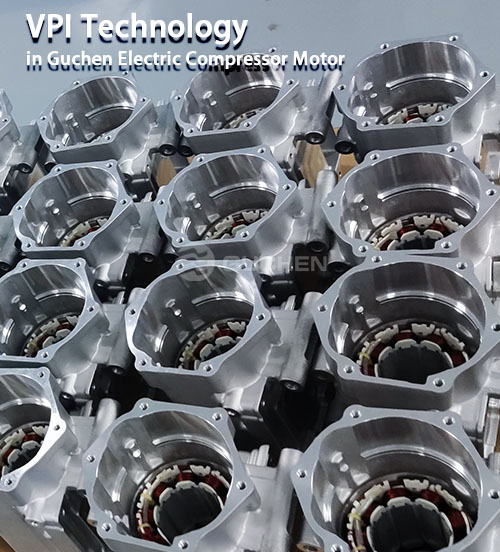In recent years, both domestic and international automotive and technology giants have launched high-voltage platform production vehicles and solutions, signaling a clear industry trend.
High-voltage platforms offer significant advantages, notably improving charging efficiency, vehicle power performance, and driving range. However, high-voltage architecture requires re-adaptation of components such as battery packs, electric drive systems, PTC heaters, air conditioners, and onboard chargers, significantly impacting the upstream and downstream of the supply chain.
Among them, electric motors face higher insulation requirements under high-voltage platforms, including adapting to 800V insulation standards and higher thermal-grade copper wires. Insulation enhancement techniques include the use of PI + inorganic nano composite materials, multi-layer enameled wire processes, and VPI (Vacuum Pressure Impregnation). This article focuses on the application of VPI in electric compressor motors.
 VPI vacuum impregnation tank
VPI vacuum impregnation tank
What is VPI?
VPI is a process widely used for the insulation treatment of electric motor windings, especially in electric compressors. The procedure typically involves the following steps:
Vacuuming – Removes air, moisture, and impurities inside the motor to prevent bubbles or voids in the insulation.
Impregnation – Under vacuum, insulation resin (or varnish) is introduced to thoroughly penetrate the windings.
Pressurization – Pressure is applied to force the resin into microvoids and ensure full saturation.
Curing – The resin is heat-cured to form a solid, high-strength, and high-insulation protective layer.
Electric compressors, especially in NEVs, heat pumps, and cold chain refrigeration, contain high-voltage motors operating under high-frequency, high-temperature, and vibrational conditions. VPI significantly improves:
- Insulation strength
- Thermal stability
- Vibration resistance
- Motor lifespan
In short:
VPI is a premium impregnation technique that enhances motor insulation and reliability, and is commonly used in electric compressors.
Core Applications of VPI in Motor Insulation
The
key component in an electric compressor is the drive motor, usually a permanent magnet synchronous motor. The stator windings are wound with enameled wires, leaving microscopic gaps and voids that traditional impregnation methods (like dip or trickle methods) cannot fully fill. This leads to risks such as partial discharge and accelerated insulation aging.
VPI solves these issues through:
Vacuum Degassing
Creating a vacuum environment (≤10 Pa) to remove air, moisture, and volatile substances from the winding.
Pressure Impregnation
Injecting high-purity resin (e.g., epoxy, polyester) under pressure (0.3–0.8 MPa) to saturate all gaps.
Thermal Curing
Heating (typically 120–180°C) to fully cure the resin and form a dense, continuous insulating layer.
Technical Advantages:
Significantly increases Partial Discharge Inception Voltage (PDIV), enhancing high-voltage endurance.
Reduces microvoids and moisture channels, slowing electrical and thermal aging.
Reinforces mechanical strength against vibration and thermal stress.
 Guchen electric compressor motors are VPI-insulated for enhanced insulation reliability and durability.
Guchen electric compressor motors are VPI-insulated for enhanced insulation reliability and durability.
VPI Optimization for Harsh Operating Conditions
Given the complex environments faced by electric compressors—high temperatures, humidity, frequent cycling, and vibration—traditional insulation may not suffice. VPI addresses these challenges through tailored material and process enhancements:
1. High-Temperature Resistance
Materials: High-temperature-resistant resins (≥180°C), such as modified epoxy or polyimide, with thermally conductive fillers like Al₂O₃ or BN.
Process: Longer curing cycles or multi-step heating (e.g., pre-cure at 120°C and full cure at 180°C) ensure complete cross-linking and prevent softening or cracking.
2. Moisture Resistance
Resin Modification: Add hydrophobic agents (e.g., silane coupling agents) or nano waterproof fillers (e.g., SiO₂) to reduce water absorption below 0.5%.
Multi-layer Impregnation: Apply VPI in cycles (e.g., vacuum + pressure steps repeated 2–3 times) to build thicker, more robust insulation barriers.
3. Vibration Stability
Improved Interface Bonding: Use plasma surface treatment or coupling agents (e.g., epoxy-silane) on copper wires to enhance resin adhesion.
Optimized Pressure Strategy: Apply gradual pressurization (e.g., pre-pressure at 0.3 MPa, final pressure at 0.6 MPa) for uniform resin distribution and minimal stress concentration post-curing.
Comprehensive Performance Benefits
Efficiency & Reliability: VPI-insulated windings reduce eddy current loss and improve reliability by preventing short circuits from insulation failure. Studies show VPI motors can achieve lifespans over 10 years, increasing durability by 30%+ compared to conventional methods.
Environmental Adaptability: VPI allows operation in extreme conditions (-30°C to 120°C, RH 85%), making it suitable for NEVs, HVAC systems, and more.
Compact & Lightweight Design: Enhanced insulation performance allows for thinner insulation layers and more compact winding structures—crucial for space-constrained automotive applications.
Industry Adoption and Future Trends
Leading global electric compressor manufacturers—including Denso, Hanon System,
Guchen Industry—are adopting VPI technology in their high-end product lines.
Examples:
NEV High Voltage Compressors: VPI with high-temperature resins supports high-frequency inverter-driven motors, reducing demagnetization risk in IPM motors.
Residential Inverter Air Conditioners: Moisture-resistant VPI combats insulation failure in humid climates, lowering maintenance costs.
Future Outlook
VPI will increasingly integrate with nano-composite insulation materials and smart process monitoring technologies (e.g., real-time resin infiltration analysis) to drive innovations in efficiency, durability, and reliability across electric air conditioning compressor applications.
VPI technology plays a pivotal role in improving insulation reliability at the microscopic level, effectively addressing motor failure risks under harsh conditions. As material science and process control technologies evolve, VPI will expand across more product lines, driving the
high-performance evolution of the electric compressor industry.





